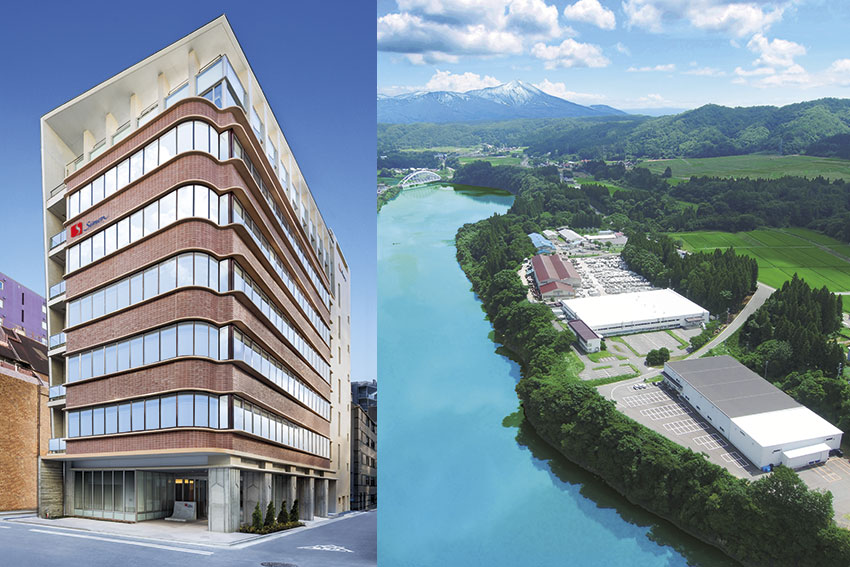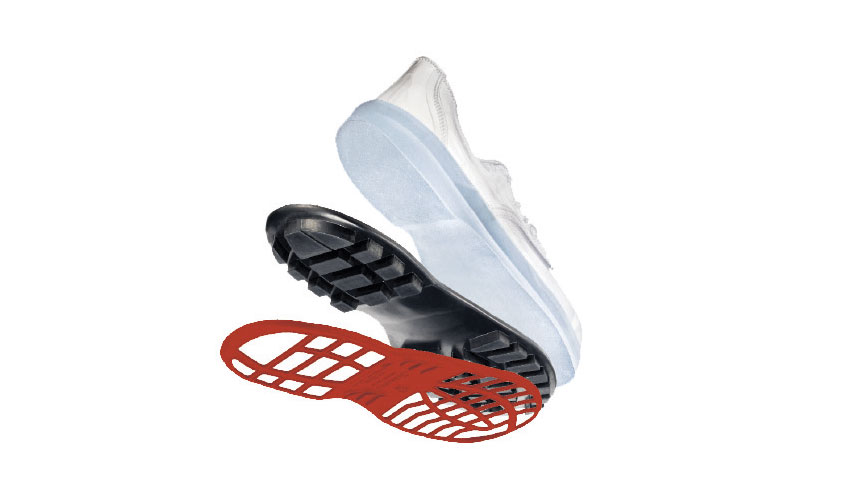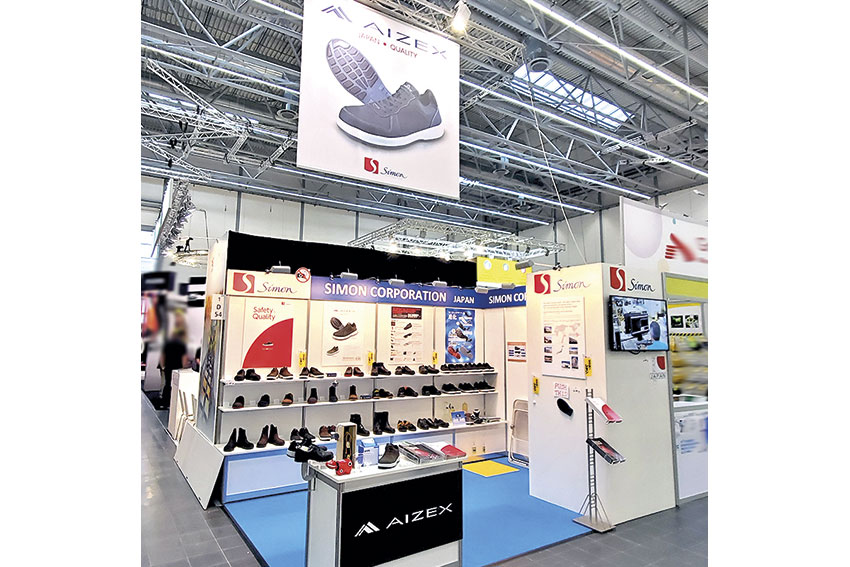Shoe manufacturer Simon leverages the Japanese manufacturing philosophies of monozukuri (craftsmanship) and kaizen (continuous improvement) to develop the best-quality safety shoes on the market.

What is your manufacturing philosophy or monozukuri that allows your firm to continue to excel in the global market?
All consumers in Japan are detail obsessed; even for a single shoe they really care about the finer details. When I visited the factory of a safety shoe manufacturer in France, I saw their assembly line, and the way that the shoes were being processed. Everything was flowing seamlessly, and in the end, they were packaged and delivered in a smooth and orderly fashion. While we wanted to fully adopt that process for our Japanese clientele, it just wouldn’t cut it, and we realized that we had to put even more effort into the final stages to ensure that the finishing touches were perfect before they were sent out for delivery. When it comes to having a global competitive edge like other global giants’ enterprises, the monozukuri culture exceeds the requirements of global standards, and therefore affects competitiveness when it comes to the worldwide market.
We understand that going beyond expectations when it comes to providing finishing touches is something that is very specific to the Japanese market, and therefore may not be necessary for the global market. Therefore, we have been focusing on how we can be relevant globally as well. We have been assessing what parts of the assembly line and manufacturing process can be streamlined and automated, in order to maintain the monozukuri attention to detail while at the same time maintaining our global competitiveness. We want to ensure that we have a steady and consistent manufacturing process in the middle stages, so the effort can be placed at the end.
In the past, all the processes were done manually. Laborers would cut each piece of leather that was used for the shoes but now we automate that process. We are continually striving to refine the manufacturing process, and to increase the efficiency of the assembly line, all while maintaining our high level of quality control. While elements such as the cutting of the leather is automated, the sewing process is still done manually. Other elements such as the manufacturing of the sole itself and its attachment to the shoe can be done by different machines. However, once the sole is attached to the shoe, fine polishing and specific cutting requires manual labor. Through a combination of automation and manual labor, we strive to make our assembly line as efficient as possible and solidify a high level of quality.
Another activity that we are promoting when it comes to work culture within the manufacturing processes, is emphasizing the importance of considering that the person who we are providing a service for is the person involved in the next step of the assembly line. Each individual takes this responsibility to ensure that there are as few defects as possible in their sphere of control, so when they pass it onto the next stage in the assembly line, defective items are properly identified. This philosophy that the person in the next step of the assembly line is who we are as staff service, ensures that we continually create the best products possible, of course always keeping in mind that the end user is also our client.

Left: Simon Headquarters (Japan). Right: Yanaizu Factory (Japan)
Is there a particular detail or feature of the Simon Brand that you feel strongly about, and that you want to be associated with your products?
Within our SX 3-layer shoe, our slip resistant technology is what we pride ourselves on. If you do the research, you will see that in Japan a large number of labor accidents or accidents in general are the result of somebody slipping and then falling. This is more prevalent when it comes to older laborers. We combine three layers together to create a hybrid sole. While the sole remains flat, it is still able to maintain a high-level of slip resistance, even if the ground is not flat. As for other soles in the industry, they utilize a sole pattern within the sole and work until the cleats themselves start to wear out. Their slip resistance is then reduced. However, we utilize a different S-pattern, which is combined with specialized materials, this creates a solid slip resistance system that we are very proud of.
The longevity of your products is another key feature. In your corporate video, you spoke about a suspension system that functions similar to that of a car in order to ensure that slip resistance is maintained. Can you provide more details about this suspension system, how it works, and how it contributes to the longevity of your footwear?
It is not the suspension system alone that is responsible for creating the slip resistance and longevity. Rather, we are able to create this long-term slip resistance through a combination of various elements, such as the S-pattern of the sole, which actually expands the contact surface of the areas that the sole touches when walking. This is combined with the materials that we utilize in the creation of the sole and the shoe. These materials are made using very specific technology that we developed together with another company. This has allowed us to enhance the slip resistance qualities of our shoes. The suspension system itself ensures a stronger grip and reduces slipping and falling even when walking on very uneven ground.
Regarding the different layers of the sole, one layer is made of polyurethane and two layers are made of rubber. These three layers, the midsole, out-sole, and frame-sole combine in this way.

SX3-Layer Sole (Separated)
This combination improves the durability and the cushioning. Traditionally with soles, there is one element that touches the ground. The center of gravity is where that area touches the ground and the rest of the sole touches it. The whole shoe changes shape according to the portion that touches the ground. However, when it comes to our sole, the way it is created is similar to how you would utilize an analogue calculator, where when you push one button, but the buttons around it do not move. Similarly, if part of the foot touches the ground, the rest of the sole does not change its shape, which allows you to maintain a firm grip and improve slip resistance.
You mentioned the importance of collaborating when it comes to the material composition. This is an ongoing theme throughout our report, especially international collaboration, when creating products for the global market. Are you currently seeking any overseas partners?
We are always thinking about different partnerships both domestically and globally. I believe that when it comes to shoes and the global market for soles, there are many amazing companies that I respect and admire, such as Vibram soles, and Michelin Tires who also produce soles. The fact that Vibram has been able to maintain such a solid presence in the industry, by continually working to improve their soles, is very impressive. As a company working in the industry of safety shoes, one important element of that is the sole of the shoe. We are always looking to continue to improve the technology of our soles and implement the kaizen philosophy to do so. This ceaseless pursuit for better and better quality, means that we are open to partnerships and co-creation. We are always in contact with other companies and are aware of the R&D technological advances being made in our industry.
Process automation is also a very important area for us to put our efforts into. We want to improve our processes by implementing the best technologies available, and therefore, we are interested in the various companies that are creating the machinery that is being used in the manufacturing of shoes. We are looking at companies in Europe and China, as well as Japanese companies. Our products require custom ordered machinery, so from that perspective too, we are looking at different equipment suppliers that can support our process automation.
Another area where co creation and partnerships are interesting for us is when it comes to procuring the materials that we utilize. For example, when considering SDGs and how to reduce the environmental burden, we are looking for suppliers who are developing more eco-friendly materials, such as plant-based leather. Whether that is applicable to the development of safety shoes, is something that we would have to test.
I consider everyone that we work with as a partner of ours. We do not exist in isolation, but only as a result of partnering with the different companies that we work together within our network, from machine equipment suppliers and those that make the soles, to material suppliers and those that do the weaving. I consider all those who work with us at different levels of our manufacturing as partners.
Recycling of safety shoes and PPE continues to be a key market trend. Can you give us a quick overview of your initiatives for sustainable development?
In terms of our safety shoes, we collect some of them for inspection services. The collected materials are mainly thermally recycled. We also ensure that we have responsible waste management systems in place when it comes to different materials, and how they should be catered too. At the manufacturing level, we constantly pursue ways to be more and more eco-friendly. One thing is for sure, we have introduced an environmental management system based on ISO 140001. We do have standards in place. We began to implement this in 2000. Within the Japan leather safety footwear market, we were the first to introduce this system.
Our Yanaizu plant is actually located in the Echigo Sanzan-Tadami Quasi national park in Fukushima Prefecture, Japan. That shows the degree to which the factory is eco-friendly and proves our commitment to the preservation and conservation of the surrounding nature. We would like to install solar panels; however, this is an area that gets a lot of snow, and the snow pile-up in winter means that it is not best suited for solar panels. That being said, we are looking at ways to further incorporate renewable energy sources at our plant.
With regards to the actual materials that are utilized in our shoes, that is definitely still an area that we need to tackle, especially as we still use leather, polyurethane, plastic and rubber. We need to work with partners to find ways to implement greener materials. This is a key challenge of ours. For example, there are many eco-friendly and stimulating materials such as those made from plants. However, when it comes to safety shoes, they require a high level of durability, and need to be oil and chemical resistant. They also need to meet the safety requirements that are in place, which means that it takes longer to implement more eco-friendly materials. They require continual testing and research to see if they are really the best fit.
Simon has a strong presence in Southeast Asia, both in Thailand, China, Indonesia and more recently in Vietnam. Are there any other markets that you consider key in terms of your international development and expansion? What is your strategy to market yourselves in these kinds of markets where cost is often prioritized over quality?
In terms of our international strategy, apart from Japan, we will continue to expand our presence in the ASEAN and China. We already have offices there so we would like to expand further.
In addition to that, we are also trying to penetrate the European market. In November 2019, we actually promoted one of our products in the largest PPE exhibitions worldwide, A+A International Trade Fair with Congress, which was held in Dusseldorf, Germany.

A+A International Trade Fair with Congress
We showcased our SX 3-layer soles. We saw this as an opportunity to penetrate the European market, however, our plans had to be postponed due to Covid-19.
Within Japan, our strategy is to expand the application of our shoes beyond the manufacturer’s factory floors. We want our safety shoes to be widely used in the service sector, as well as the storage, logistics, food and beverage, and medical sectors. We want to diversify their applications, especially considering Japan’s aging population. Within Southeast Asia and China, we are trying to expand the use of our shoes in factories. In order to compete when cost becomes the biggest factor, we are targeting the high-end market. The grand reality of this industry is that there are many makers that do not have labor standards in place, and therefore release some products that do not meet safety standards. This enables them to be cheaper, but also reduces the quality of the products. There is no way for us to compete in that sphere by bringing down our prices, and therefore we do not cater to those markets.
We pride ourselves on creating products of the highest level of quality, so that when our customers take one look at our shoes, they can feel safe and secure. The aesthetics of the shoe are also very important. From that perspective, we are specifically targeting the standard and premium market.
Your company is this year celebrating its 74th year anniversary. Imagine that we came back six years from now for your 80th year anniversary as a company and have this interview all over again. What would you like to tell us? What are your dreams for this company, and what goals would you like to have accomplished by then?
As you know, our company caters to the manufacturing of leather gloves and safety shoes in particular. When it comes to our safety shoes, we are still producing these shoes through our original manufacturing method, and we are implementing monozukuri in doing so. For me, constantly conducting product development to continually push the barriers and create the best safety shoes is key. We want to make our shoes even safer and more comfortable, and perhaps promote the health benefits and well-being of those who wear them. That is something that I put most of my energy into and want to continue going forward. We want to put our efforts into R&D, and also ensure that everyone that is involved in our endeavors, can all maintain solid relationships and lead fulfilling lives together. If I can do that during my time as president I would consider it to be a very successful and worthwhile tenure.
Those three elements; the constant pursuit of greater safety, comfort and health, are my main goals. When it comes to health, promoting the health and wellbeing of individuals is a critical challenge. There is a big difference between lifespan and healthspan, and that difference is ten years, here in Japan. You could be living longer, but if you are not healthy then what is the meaning of that? While I do not have the exact numbers to give you at this moment, there are many cases in which people slip and fall, and end up being bedridden, and therefore not living the best quality of life that they could have if the accident had not happened.
I used to be into running marathons. Ten years ago, I was a runner. I overdid it and ended up with plantar fasciitis. I had an inflamed sole which was very painful for around two years. It hurts to walk, and even stand. I have heard from clients and laborers with inflamed soles or similar injuries, who are on their feet most of the day. I can relate to this from my own experience. On one occasion, when I was visiting a tire maker, one of the laborers shared that his soles were in pain but wearing our WS11 shoes eased the pain and provided some relief to him. This was nice to hear. When I had my own injury, I was not able to wear regular business shoes made from rubber. However, I was able to experience some relief from the pain by wearing our Simon SX3-Layer sole Safety shoes. The cradling insoles really helped me at that time. Eventually, my injury was healed through acupuncture as well as having a custom insole being made for me. It is from my personal experience that I have this ambition to continually pursue shoes that not only have high levels of safety and comfort, but also enhance the health of those who wear them.
0 COMMENTS